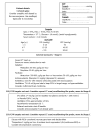Neuroprotective measures in children with traumatic brain injury
- PMID: 26855892
- PMCID: PMC4733454
- DOI: 10.5492/wjccm.v5.i1.36
Neuroprotective measures in children with traumatic brain injury
Abstract
Traumatic brain injury (TBI) is a major cause of death and disability in children. Severe TBI is a leading cause of death and often leads to life changing disabilities in survivors. The modern management of severe TBI in children on intensive care unit focuses on preventing secondary brain injury to improve outcome. Standard neuroprotective measures are based on management of intracranial pressure (ICP) and cerebral perfusion pressure (CPP) to optimize the cerebral blood flow and oxygenation, with the intention to avoid and minimise secondary brain injury. In this article, we review the current trends in management of severe TBI in children, detailing the general and specific measures followed to achieve the desired ICP and CPP goals. We discuss the often limited evidence for these therapeutic interventions in children, extrapolation of data from adults, and current recommendation from paediatric guidelines. We also review the recent advances in understanding the intracranial physiology and neuroprotective therapies, the current research focus on advanced and multi-modal neuromonitoring, and potential new therapeutic and prognostic targets.
Keywords: Advanced neuromonitoring; Intracranial pressure; Neuroprotection; Paediatric critical care; Paediatrics; Traumatic brain injury.
Figures
References
-
- Langlois JA, Marr A, Mitchko J, Johnson RL. Tracking the silent epidemic and educating the public: CDC’s traumatic brain injury-associated activities under the TBI Act of 1996 and the Children’s Health Act of 2000. J Head Trauma Rehabil. 2005;20:196–204. - PubMed
-
- Faul M, Xu L, Wald MM, Coronado VG. Traumatic brain injury in the United States: emergency department visits, hospitalizations and deaths 2002-2006. Centers for Disease Control and Prevention, National Center for Injury Prevention and Control. Available from: http://www.cdc.gov/TraumaticBrainInjury.
-
- Tagliaferri F, Compagnone C, Korsic M, Servadei F, Kraus J. A systematic review of brain injury epidemiology in Europe. Acta Neurochir (Wien) 2006;148:255–268; discussion 268. - PubMed
-
- Teasdale G, Jennett B. Assessment of coma and impaired consciousness. A practical scale. Lancet. 1974;2:81–84. - PubMed
-
- Shaklai S, Peretz R, Spasser R, Simantov M, Groswasser Z. Long-term functional outcome after moderate-to-severe paediatric traumatic brain injury. Brain Inj. 2014;28:915–921. - PubMed
Publication types
LinkOut - more resources
Full Text Sources
Other Literature Sources


